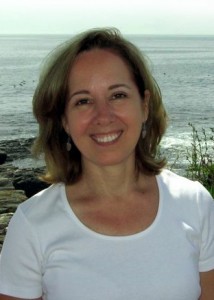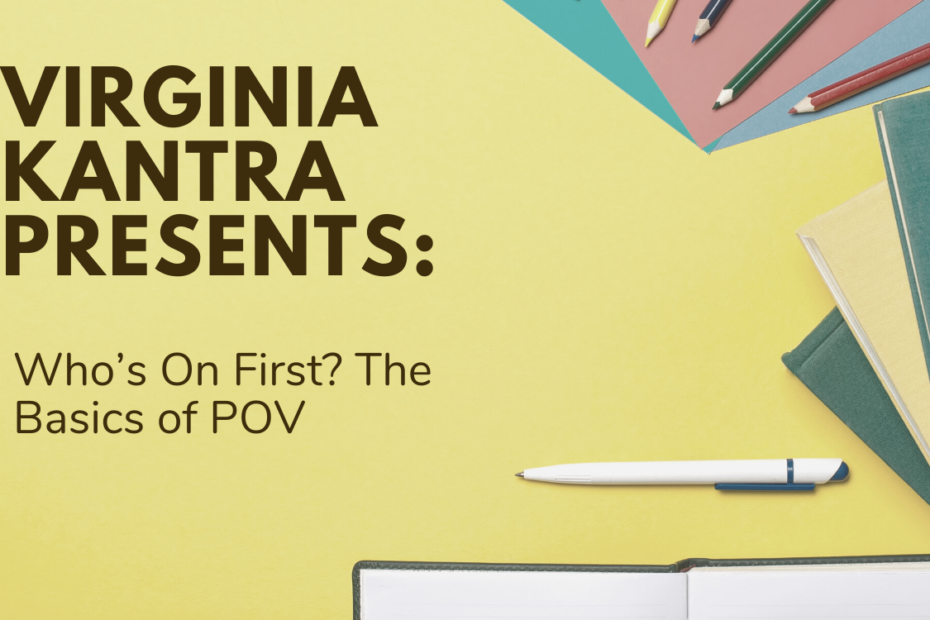You read just one of Virginia Kantra’s books and you know that she is a master in the craft of writing. After I spilled water all over her at RWA Nationals last year (Sorry, Virginia!), I had the gall to ask her to come and share her knowledge with all of us at RU. As she dried off, she graciously agreed to join us and today is the first of a two part series on POV. The second part will be posted on June 22. Welcome Virginia!
Who’s on First? The Basics of Point of View – Virginia Kantra
There are a lot of rules about point of view. Does everybody remember in Star Wars when Luke Skywalker seeks out Yoda and says something like,
Well, before we get started I need to make it clear that when it comes to point of view, there is no “right.” There is only “works” or “does not work.”
To understand how point of view works, we first need to nail down some basic definitions. To get really basic: point of view is the vantage point from which the story is told.
In first person point of view, the story is told by one of the characters: the “I,” the narrator. Think
Jane Eyre
In third person point of view, “I” is replaced by “he” or “she.” The narrator is outside the story.
My son’s high school writing handbook, Writers Inc defines three different kinds of third-person point of view, each like a different camera angle:
1. Omniscient – “in which the narrator shares the actions, thoughts and feelings of all the characters in the story at will.”
It’s as if the camera’s being handed back and forth between different characters within the story, so that at different times we see the action from all angles.
2. Limited omniscient – which “allows the narrator to share the thoughts and feelings of only one character.”
The character is our cameraman, so we see all the action through the filter of that one character’s observations and reactions.
and
3. Camera view or objective view which “allows the storyteller to record the action from his or her own point of view, unaware of any of the characters’ thoughts or feelings.”
Think of the wide angle shot at the opening of a movie or a security camera, mounted in the corner of the room, indiscriminately recording the action.
Unless you are writing experimental fiction, you are writing in first or third person point of view.
First person has real advantages.
1. It allows you, the writer, to maintain suspense.
In JANE EYRE, for example, because we are never in Rochester’s POV, we’re left in suspense of his feelings. Does he love Jane, or is he toying with her while he pursues Blanche Ingram?
2. It allows you to conceal secrets.
The story would be much less powerful if we knew all along that Rochester had a mad wife stashed in the attic.
For a contemporary example, read Marian Keyes’s funny, fabulous and chilling
Rachel’s Holiday
with its self-deluded coke addict protagonist. In common with most addicts, Rachel doesn’t believe she has a problem; and because we’re in her POV, we aren’t sure either…at least not at the start.
In the first case, the secret is information is concealed from the narrator.
In the second case, the secret is an insight that is not acknowledged by the narrator.
In both cases, the reader is in suspense.
3. First person allows us to reveal character intimately. Because of its confessional nature, first person is generally good for creating emotional identification with the character. We certainly sympathize with plain, awkward, passionate Jane.
That emotional identification makes first person a good choice for Young Adult novels. First person also works well in chick lit, with its focus on self discovery, because it drags the reader along on the protagonist’s journey.
Even when the viewpoint character is an unreliable narrator whose choices we may not agree with or whose perceptions of others are flawed, we still get to know the character intimately. And the reader’s ability to read between the lines can creates a wonderful irony. In Kristan Higgins’ My One and Only , for example, the reader quickly perceives that the heroine has never stopped loving her ex and is deluding herself about her relationship with her firefighter boyfriend. Part of the humor and the delight for the reader is waiting for the character to catch on.
First-person POV allows the writer to create suspense, keep secrets, and develop emotionally compelling characters.
But there are drawbacks to writing in first-person. For one thing, it limits the action. The point of view character must be present for us to “see” the key scenes. Bronte does a great job of working around this. When Jane Eyre is hurrying back at the end of the story, she encounters a chatty innkeeper who paints a marvelous word picture of the fire at Thorne Hall and Rochester attempting to talk his wife down from the battlements. But we’re not there. Through the innkeeper’s description, we see some of what Rochester saw; but we can only guess at what he felt.
First person POV limits our understanding of and identification with everyone but the viewpoint character. This still works in gothics, where the mysterious hero is a desirable staple of the genre. But in romances where the story often belongs equally to the hero and heroine, this is a real drawback.
I mentioned that first-person is great for irony, which is why it works so well in chick lit. But being forced to evaluate the observations and insights of an unreliable viewpoint character can be tiring on our readers if we don’t provide them with the yardstick of another character’s perceptions.
Third person point of view lets us view the action through more than one character. Its broader camera angle is great for scope and action. But while that allows us to witness and participate in more scenes, we’re not as immersed in the characters’ experience, and we identify with them less.
Which brings us to deep point of view or, as it is sometimes called, close third person point of view. Deep point of view is the writer’s attempt to combine the advantages of first person point of view with the convenience of third-person omniscient point of view. Deep point of view is the quickest, cheapest tool in the writer’s toolbox for shoe-horning your reader into your character’s skin.
Two things drive it: your characters’ experience and your characters’ emotions. Nobody can tell you exactly how to write your character’s deep point of view because your character’s view of the world is a function of who they are…and only you know that. But deep POV can help you bring that knowledge to the page. The basic character elements that affect your character’s view of the world are: gender, age, education, environment, time period, knowledge base, belief system, relationships, and formative events (back story). I’ll be going into these in more detail in my article for the July Romance Writers Report and when I return here to Romance University in June.
To get a sense of how some of these factors drive deep point of view, however, I’ll conclude with an excerpt from my July release, Carolina Home .
Ask yourself as you read, Which elements can you find?
Matt Fletcher didn’t go looking for trouble. Most times, it just found him.
His life was changing around him, slipping away like the sand of the Carolina coastline, and there wasn’t a damn thing he or God or the Army Corps of Engineers could do about it. But a day working on the water gave him something to hold on to. Sweat and salt cured everything in time.
The smell of fish and fuel, mud and marsh grass thickened the air as he turned the Sea Lady II toward home. The September heat pressed down, flattening the inlet like glass. The twin engines chugged. Water churned, attracting a flock of greedy gulls that cried and hovered in his wake.
He navigated the fifty-three-foot Lady past bobbing boats and narrow slips, heading for the wharf and weathered shack that served as office for his tiny charter fleet. With Joshua back in school and unable to crew, Matt had been forced to leave the original Sea Lady in dock and bring his father, Tom, along as mate. It hurt leaving a boat behind, losing business this late in the season.
But his passengers, doctors from Raleigh, wanted the kind of amenities the Lady II could provide. They hadn’t balked at the full-day offshore rate, and they’d pay to have their catch cleaned, too, three big yellowfin, two dozen dorado, a cooler full of steely-faced wahoo.
A good day all around.
Satisfied, Matt revved the diesels, swinging the Lady II around in a tight arc. Fishermen learned to accept what the sea gave and the sea took away. A captain pitted his boat and equipment, his experience and skill, against the whims of the ocean, the season, the weather. Sometimes you did everything you could do and still came home empty-handed.
Which was why Matt was grateful for good days. Like today.
***
Excellent post on the basics of POV! Is there anything about this particular aspect of the craft that you struggle with?
Laura Kaye is with us tomorrow to talk about shifting your social media perspective.
***

Steady Matt, the son who stayed
Ambitious Meg, the daughter who never looked back
And rebel Luke, the Marine who thought he’d never return…
Home to the Fletcher family for generations, Dare Island is a fishing village rocked by changing times-its traditions slipping away like the sands of the North Carolina coast. Single dad and fishing boat captain Matt Fletcher deferred his own dreams to support his innkeeper parents and build a future for his sixteen-year-old son. Matt has learned to weather life’s storms by steering a steady emotional course…and keeping a commitment-free approach to love.
Newcomer Allison Carter came to Dare Island to escape the emotional demands of her wealthy family. The young teacher aims to build a life here, to make a lasting place for herself. She doesn’t want to be another in the long line of Women Who Once Dated Matt Fletcher. It’s both tempting and dangerous to believe she can be something more.
Then Matt’s brother Luke makes a sudden return home, with a child of his own-and a request that will change all their lives. With a child’s welfare at stake, Matt must turn to Allison to teach him to let go of the past, open his eyes…and follow his heart.
Bio:
New York Times bestselling author Virginia Kantra has written over twenty books of contemporary romance, romantic suspense, and paranormal romance. She is the winner of numerous writing awards, including Romance Writers of America’s RITA Award and two National Readers’ Choice Awards. Married to her college sweetheart and the mother of three kids, she is a firm believer in the strength of family, the importance of storytelling, and the power of love.
Her favorite thing to make for dinner? Reservations.
